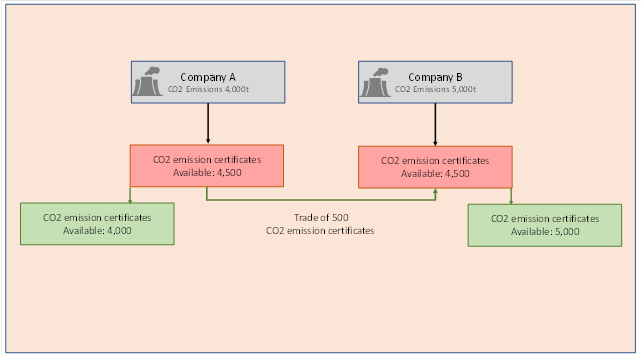Tokenisation of sustainable aspects and CO2 emission
One of the most important goals of policies related to climate change is to reduce greenhouse gases (“GHG”) in our atmosphere. In this context, companies are tasked to produce in a more climate-friendly manner. Also, the population is keen to support green projects. In the past this was either possible at great expense or through donations. Donations in particular, however, were lined alongside a large number of projects and thus did not play a prominent role in case such donations were relating to GHG reducing projects.
With the increasing development of technical possibilities, however, the potential to participate actively in green or sustainable projects increases massively. This is also the case in view of the prominent blockchain and token technology.
Green/Sustainable Token
Based on blockchain technology, various ways in order to track token holder’s carbon footprint or other sustainable/green aspects are currently developed. For example, this might be applied on a basis model via companies including their sustainable references on the blockchain. Since one of the key functions of a blockchain is that it is publicly accessible, everybody can access the respective company’s information (e.g., in order to plan an investment).
Beyond the aforementioned disclosures on the blockchain, also the token might relate to sustainable/green projects. “Tokens” (technically similar to Bitcoin, Ether or Tether) are digital representations of something that typically can be transferred based on a blockchain protocol. This something might relate to an endless variety of aspects which can be coded in the Token (“Tokenization”). Token might be fungible, which can be compared to a banknote – it is not important which banknote exactly someone owns, but rather that it owns such banknote at all, or Token might be non-fungible, which can be compared to a painting – in which case it is very important that someone owns the specific painting and not a mere copy. The latter is also referred to as non-fungible Token (“NFT”).
One of the various ways to Tokenize sustainable aspects might be by way of including the obligation that for each Token or NFT a certain amount of CO2 emissions will be reduced. Since the blockchain technology is publicly accessible, everybody would be able to check the amount of Tokens or NFTs that the respective participants are holding and thereby can assess how many CO2 emissions the respective participant has reduced.
Tokens or NFTs might also grant the promise to plant a tree in case a specific number of Tokens or NFTs are transferred to a participant on the blockchain. This might also be included in a game in form of a special feature (e.g., as an NFT) in order to increase the inducement to gather and collect NFTs (in the game) and thereby to trigger an actual green affect (e.g., having a participant to plant a tree).
Blockchain technology also can be used to track down the amount of CO2 emissions in a supply chain: Each Token would refer to the CO2 emission of a part of the product, making it easy to track down CO2 emissions allocations to respective producing steps in a supply chain and thereby help to define key positions of where to reduce CO2 emissions in that supply chain. Besides, it will provide a total overview of CO2 emissions of a product.
Tokenization of CO2 emission certificates
By far more complex is the scope of application in view of Tokenization of CO2 emission certificates.
The Kyoto Protocol, dated 2005, obliged the participating countries to reduce GHG emissions. The amount of GHG that may be emitted in terms of certain activities should be reflected via CO2 emission certificates. Trading of CO2 emission certificate was introduced to give companies an incentive to become more climate-friendly; for example, in case they manage to reduce their GHG emission, hence, they do not need an CO2 emission certificate, they can sell such CO2 emission certificate to another company that would otherwise cross its GHG limits.
Mechanism of CO2 emission certificates
For each tonne of GHG emitted, a so-called CO2 emission certificate is required, which allows the company to emit a certain amount of a GHG in a certain period of time. Although there is a limited number of CO2 emission certificates available in the market, there is no maximum number per participant in the CO2 emission certificate trading market (“Participant”).

Therefore, in case a Participant foresees that the CO2 emission certificates, it is entitled to draw are not sufficient in relation to the tonnes of GHG this Participant is going to emit, it can stock up its CO2 emission certificates by buying additional CO2 emission certificates.
CO2 emission certificate NFTs on Blockchain
CO2 emission certificates are genuinely drawn down /issued online. Hence, this fundamental tendency towards digitalisation makes it easy for implementation within the blockchain / token universe. Only drawing of CO2 emission certificates must be performed via official national platforms, whereas the trading is left to the market.
The trading of subscription rights regarding CO2 emission certificates via usage of NFTs - is new in its development. The NFTs data typically includes a reference to a unique source outside of the blockchain that makes the NFT non-fungible. Such reference might be designed as a specific subscription right to a CO2 emission certificate. By using the data included in an NFT, a Participant is enabled to subscribe to a specific CO2 emission certificate on an official platform (so-called Tokenization of CO2 emission certificates).
In this context, the NFTs can digitally mediate access to CO2 emission certificates to be created in the future, which will be assigned to the respective holder (Participant) of the NFT through drawing down (subscribing to) the CO2 emission certificate via entry in the emissions trading register (or a comparable official register).
Besides enabling an easy way to trade CO2 emission certificates, this also enables the current or previous holder of the NFT to provide proof of the existence of CO2 allowances. Since the NFT will also show when a Participant has drawn down (subscribed to a) CO2 emission certificate, this information can be viewed by every user of the blockchain. As a result, anyone can check the previous expenditures of the holder of the NFT as well as the amount a Participant has actually drawn down (subscribed to) regarding CO2 emission certificates.
Blockchain technology and its own GHG emission
Tokenization of green and sustainable projects or subscription rights regarding CO2 emission certificates seems to be an easy way to participate on green or sustainable projects as well as tracking down and making public of green or sustainable information. However, in the past the enormous power consumption of the Bitcoin-blockchain was criticised, which would run counter to the climate protection idea.
The Bitcoin-blockchain was based on a technology that required a large amount of computer power in order to validate the transactions performed on the Bitcoin-blockchain. Therefore, often many computers, were set up in line to process the Bitcoin network. There was a huge interest in putting these efforts because Bitcoin has risen significantly in price and as a reward for validating transactions, operators have been included in Bitcoin distributions. One might remember pictures of warehouses full of computers. The Bitcoin-blockchain’s total amount of power is often compared to a small country.
Being aware of the enormous power consumption, blockchain entrepreneurs turned away from Bitcoin-like validation mechanism and developed alternative mechanics. The power consumption of the Bitcoin-like blockchain was reason for one of the biggest blockchains (Ethereum) to transfer its technology to a new validation mechanism. Ethereum announces on its website that thereby the annual electricity consumption shall be reduced by more than 99.988% and Ethereum’s carbon footprint will be decreased by approximately 99.992 % (from 11,016,000 to 870 tonnes CO2). Currently, the large majority of blockchain projects is basing its validation technology on new alternative mechanics, requiring significantly less power compared to the Bitcoin-blockchain.
Authored by Johannes Wirtz, Timo Foerster and Laura Volland




